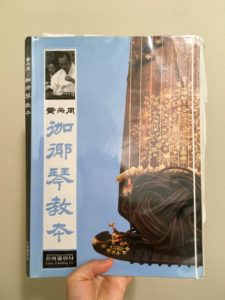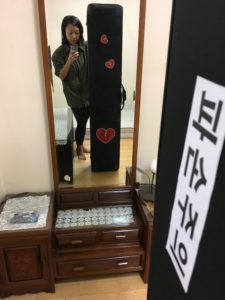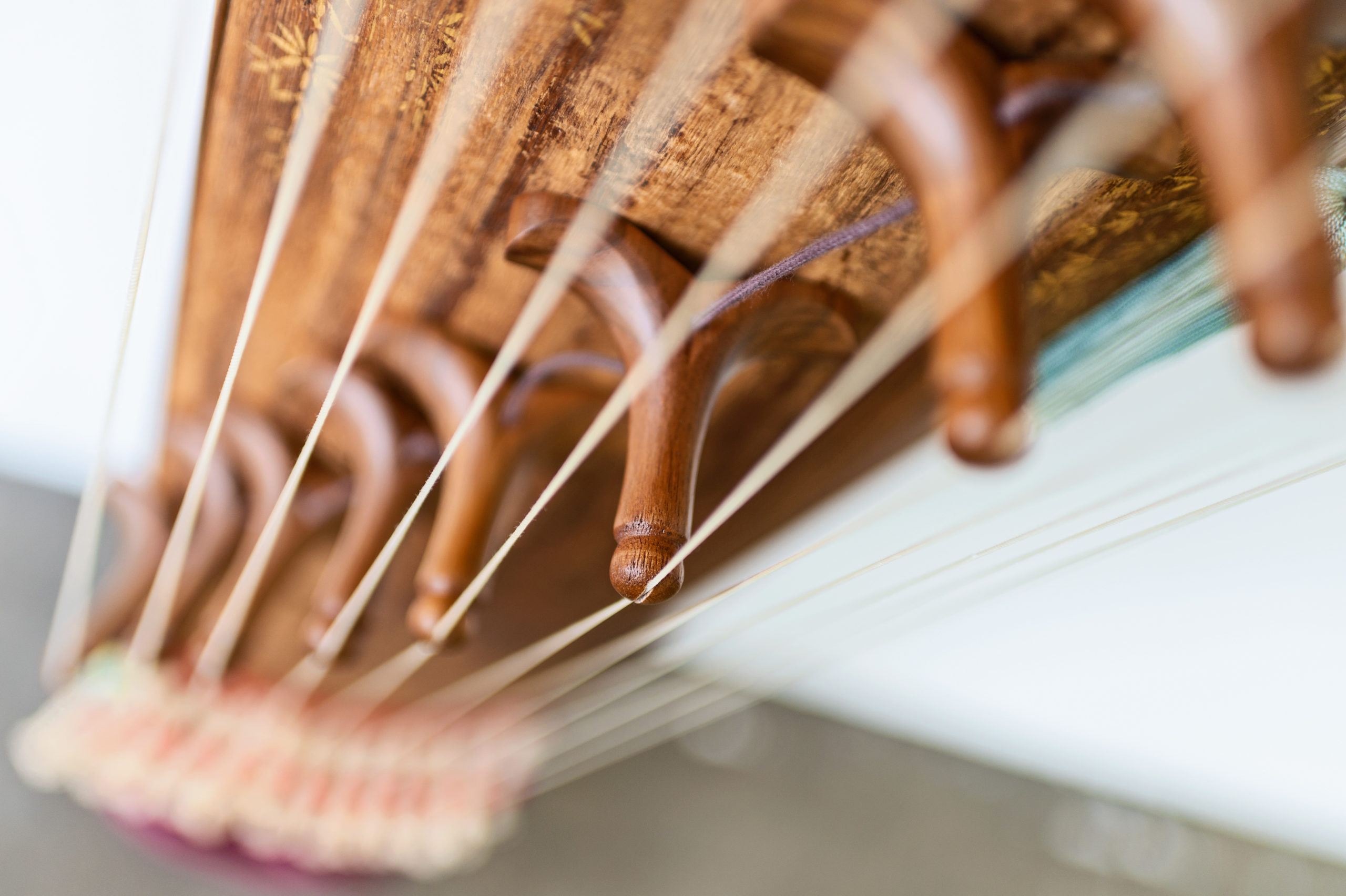12 Jun Gayageum Teacher in Los Angeles
I’ve received numerous messages about where one can find a gayageum teacher in Los Angeles so I figured I’d write it up in this blog post for inquiring minds.
Where can I take gayageum lessons in Los Angeles?
You might have found me through my album “Dream of Home” where I do indeed play gayageum. Unless you are wanting to learn gayageum to play primarily in contemporary contexts like I do, I would suggest teacher Ji Yun-Ja 지윤자 선생님 in LA, who teaches out of Koreatown. I can’t find her contact info online so write me or the Korean Cultural Center for her information. I have not taken lessons with her so I cannot vouch for her teaching abilities but she is as legit as they come as daughter of the late intangible asset Sung Keum-Yun 성금연 선생님. And there may be other gayageum teachers in Los Angeles that I’m not familiar with.

The Sung Keum-Yun school is also the one my late teacher 고순옥 선생님 comes from. There are just a handful of schools, each under an intangible asset (a designation by the Korean government akin to something like the NEA jazz masters except there are far fewer intangible assets of gayageum, like only several total instead of several each year … so not really equivalent actually) of gayageum. Most likely though, no matter what school your teacher is from, you’ll start with the Sung Keum-Yun sanjo (traditional musical form), as that is the one presented in a standard book (see pictured) that students use nowadays.
By the way, if you are in Seoul and want a lesson from a good gayageum teacher, I recommend the one I studied with, Yuny Park. While not every professional gayageum player shows mastery over the instrument, Yuny 언니 is excellent at the traditional repertoire and her technique is solid.
From my late teacher, I learned the old-school way first for two years, mirroring her in frequent lessons with no notes or recordings of any kind, and that was tremendously beneficial in a number of ways and a huge gift to my life. Then having lessons with Yuny 언니 where I learned in a more methodical and now-standardized way with notation and books—directed by technical comments rather than metaphors and riddles—gave me a good balance.
If you want to play contemporary pieces and your own songs on gayageum (or want voice lessons), feel free to contact me. I would still recommend that you mix in lessons with a traditional teacher to get a sturdy foundation because no matter what genre you play on the gayageum, you should still learn some traditional repertoire to understand what the instrument sounds like, what Korean music sounds like.
Where can I buy a gayageum? Can I purchase one in Korea and have it shipped?
I have no experience purchasing a gayageum as mine were passed down from my teacher. I did take two to Korea while living there and had to bring them back to the States with me. I did this in two different ways:

(1) For one gayageum, I bought a hard case for it (slightly discounted from a friend of a friend for around $200 USD) and checked it on the international flight. I took Asiana Airlines and the fee to check oversize baggage was 400,000 won (at the time converted to $357.06 USD + $10.71 foreign transaction fee on my credit card). So if you’re hesitating to buy a gayageum in the US because you think the price will be marked up, that may be true but know that the cost to transport a gayageum from Korea on your own can be significant. And it was a bit nerve-racking waiting for my gayageum in the hard case to be returned to me as it could be lost or the wood could potentially crack if handled carelessly. The other option would be purchasing a seat for the gayageum and carrying it in a soft case. I do this on domestic flights.
(2) For my other gayageum, I shipped it from a gugak instrument store in Seoul. I can’t remember the exact cost but I want to say it was around $150-200 to send the gayageum zipped in its soft case and they packaged it expertly in cardboard and padding. The store is called Hanullim 한울림국악기 (off Yangjae Station 양재역 in Seoul) and I’ve only had good experiences with them. This is also a good place to buy various folk instruments like little drums, accessories like instrument bags and likely also student gayageums, in addition to having your gayageum shipped via air securely and economically.
How much does a gayageum cost?
Again, I’ve never purchased one myself but from what I’ve heard you can get one in LA starting at around a thousand dollars. As far as musical instruments go, that’s pretty inexpensive so I don’t know how good it would sound. Having been primarily a vocalist without an external instrument to carry around for most of my life, I didn’t understand the way instrumentalists would obsess over instruments, reeds, mouthpieces, etc. but it makes sense now: I think I assumed all gayageums sounded like my late teacher’s instruments until I tried a spare one my friend had for students and discovered it sounded like a plastic toy.

Unless you are going to be a professional sanjo player though, there’s no need to splurge on a top-of-the-line gayageum, like one made by the intangible asset of gayageum-making 고흥곤국악기. In fact, I’d hold off on buying an instrument at all, if possible, until I was sure that I would stick with the lessons and continue to play gayageum.
If this is for a small child, you might want to try to find a smaller gayageum (like getting a half-size violin until the child is big enough for the full size). I know they exist though I don’t know where you’d buy one. I’d ask a shop like Hanullim.
How old should my child be to take lessons?
I’ve heard that if they are only in second or third grade, it’s a bit too young (of course, if you’re one of those prodigies featured on the Korean daytime shows, it’s a different story). I know that won’t deter determined parents from signing up their kids but I’d venture to guess that it might be a better use of time and resources to cultivate curiosity and interest by immersing them in the arts through interactive workshops, shows and the like rather than structured lessons for young children who show no proclivity for a particular instrument.
Gayageum players and other folk musicians do start at a fairly young age. It seemed to me that people in Korea typically go to a specialized traditional arts middle school, then a traditional arts high school then onto one of the college programs. So I’m guessing they start around middle school or a bit before.
How much does a lesson cost?
For music lessons in general from trained, practicing professionals, I’d expect to pay in the ballpark of $80-120 per hour. Of course, there are some who charge more and some who charge less, and it varies from teacher to teacher.
For beginning students on any instrument, I wouldn’t necessarily recommend that they go to a cream-of-the-crop musician or a high-level teacher because if they’re learning fundamentals, they may be able to get what they need on a smaller budget from a local music academy or a neighborhood teacher. With gayageum in the States, however, you don’t have so many options for teachers and the fee may well be higher for a master teacher. If you’re not in LA, see if there’s a Korean Cultural Center in your area and ask if they offer classes or have a teacher recommendation.
Keep in mind that a musician being a remarkable or renowned performer does not translate to the person also being a skilled teacher. But again with gayageum, you have limited options outside of Korea. While distance learning is possible and you could potentially take a lesson from someone in Korea via Skype, I don’t think that would be as fruitful as in-person lessons, especially if you are just starting out and getting a feel for the instrument.
What else should I keep in mind?
If you don’t know Korean, I’d strongly suggest learning the language prior to or in conjunction with gayageum lessons. Even if the lessons can be taught in English, it’s not possible to properly learn folk music without understanding the language.
Other questions related to finding a gayageum teacher in Los Angeles?
Feel free to leave questions in the comments and I’ll address them.
(Post published in 2019)


Jocelyn Clark
Posted at 01:13h, 13 DecemberI’ve recently commissioned a foldable gayageum from Nangye Gugakgi (http://www.nangyekukak.or.kr). It folds in to smaller than a violin case and can be taken as carryon luggage. Mr. Jo sends internationally and the price, $1,000-$5,000, is reasonable. I’ve been playing on the professional model recently and am happy with the sound. There is the hassle of reconstituting the instrument after travel but It’s not that bad compared to the $$$ saved, you just have to know what you’re doing. Just an FYI 🙂
voicekwon
Posted at 19:05h, 13 DecemberThank you for the useful information! I’ll definitely look into that if I decide to purchase a gayageum in the future.
Joanne Park
Posted at 22:30h, 16 JanuaryIs there a place to rent Gayageums?
voicekwon
Posted at 08:50h, 17 JanuaryHello, I’m not sure but you could contact the Korean Cultural Center to see if they know.
Lina Lam
Posted at 14:43h, 15 MayHello Ms. Kwon. thank you for giving this valuable information on where to find a gayageum teacher, as they are hard to find (referring to US). Yes, I know the instructor you mentioned in the article, Ji Yun-Ja. She goes by her English name, Esther. I took a trial lesson with her a long time ago. Hopefully I will be to find the time commit to taking gayageum lessons with her in the future.
I also wanted to mention, that you can find gayageums on Ebay. There is a traditional musical instrument store in Hacienda Heights, called “Sound of China”. They also sell gayageums. Hope this helps.
voicekwon
Posted at 20:48h, 15 MayThanks for the additional information!
Chris
Posted at 13:12h, 01 MayI can not find any classes and I really want to learn. Can you help me?
voicekwon
Posted at 13:05h, 23 SeptemberHi Chris, sorry I’m just noticing this comment. Feel free to email me for information on where you might take lessons.